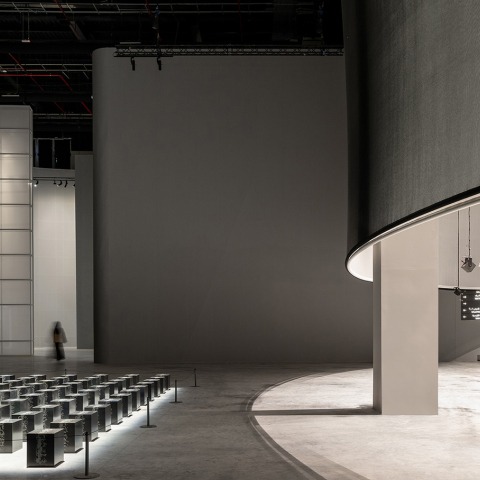The Biennale give also the opportunity, in a separate gallery named AlMadar, or The Orbit, twelve local and international institutions including Kuwait’s Al Sabah Collection of Islamic art, together with an exhibition that pays homage to the Hajj Terminal – both celebrating their 40th anniversary.
The project is OMA’s first built work in Saudi Arabia and marks a new chapter in the office’s long-standing involvement in the country. OMA’s portfolio in the Middle East includes projects such as Qatar National Library, the headquarters of the Qatar Foundation and Concrete at Alserkal Avenue in Dubai. OMA’s think tank AMO has published extensively on the rapid urbanization of the region in two special issues of Volume magazine, Al Manakh (2007) and Al Manakh: Gulf Continued (2010).

Islamic Arts Biennale design by OMA. Photograph by Marco Cappelletti.

Islamic Arts Biennale design by OMA. Photograph by Marco Cappelletti.
Project description by OMA
The first edition of the Islamic Arts Biennale brings together a mix of ancient artefacts and contemporary artworks, displayed over 120,000 square meters of exhibition spaces, taking over the SOM-designed Western Hajj Terminal.
The OMA-designed scenography divides the exhibition space into two complementary parts:
(1) A choreographed trajectory through a sequence of newly built galleries allows visitors a progressive sense of orientation as they move from one room to another. Inspired by the concept of the Qiblah – the direction Muslims face when they pray – the exhibits manifest gradually in a journey from darkness to light, starting in a dimly lit room filled with 17th-century astrolabes – used to calculate the Qiblah – and concluding in the bright space hosting an installation which incorporates the First Saudi Door of the Ka’bah in Makkah, installed during the reign of King Abdul Aziz.
(2) Under the terminal’s canopy, a desert-like landscape alludes to the journey of Hijrah – Prophet Mohamed’s journey from Makkah to Madinah. Slopes and slanted walls of various heights, arranged in relation to the geometry of the existing structure, have been built to display the artworks, creating a sense of exploration throughout the visit. Two freestanding pavilions act as reference points in the open landscape, exhibiting artefacts from Makkah and Madinah. In contrast to the rough atmosphere outside, the exhibits in the two pavilions are embedded in a bright, diaphanous screen wrapping the perimeter of the walls.

Islamic Arts Biennale design by OMA. Photograph by Marco Cappelletti.
Independent from the theme of the Biennale, a separate gallery named AlMadar, or The Orbit, features items from twelve local and international institutions including Kuwait’s Al Sabah Collection of Islamic art, together with an exhibition that pays homage to the Hajj Terminal – both celebrating their 40th anniversary.









































